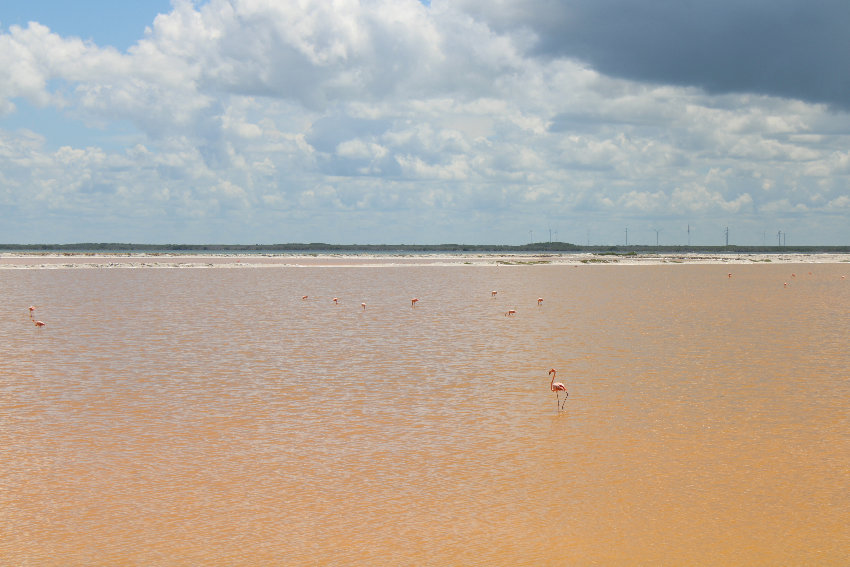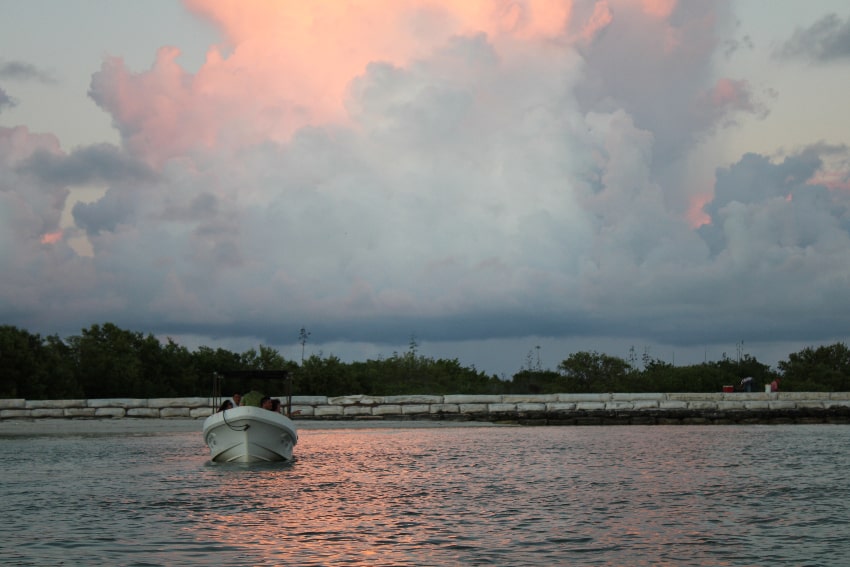A salt company’s sustainable initiative

A cottony puff of a cloud sits just above the horizon. Its reflection in the soft pink water of the Las Coloradas salt flats below creates one of the most Instagrammable shots in the entire Yucatán peninsula. All that’s needed to complete the shot is one of the hot pink American flamingos that feed there, standing one-legged in the distance.
What was once a mere industrial salt farm has become somewhat of a sensation since 2016 when mentions of the “pink beaches” of Las Coloradas where you could swim with the flamingos flooded the internet. None of those things were true, but tourists came in droves anyway to a place that used only to receive travelers who took a wrong turn on their way to Rio Largartos.
When the visitors started to wander into the salt ponds on their own, contaminating months worth of work for the Industria Salinera de Yucatán salt company, the company decided something must be done to protect their product and to allow visitors to gawk at this little natural wonder and get their shot for the Gram. So in 2021, the official welcome center of Las Coloradas was opened, and local guides were on hand to give tours that explained the process of salt production and harvest, why some of the ponds are pink (a little family of bacteria called halobacteria), and why local flamingos are so fond of this enclosed little ecosystem.
The salt flats sit in the middle of the Rio Lagartos bio reserve, designated as such in 1999. The Industria Salinera de Yucatán had already been producing salt there since 1946. When the area became federally protected, salt production was deemed a suitable and sustainable commercial activity allowed to continue there. The 10 to 12 month process of producing salt from seawater starts with water pumped directly from the saltwater lagoon between the ocean and the salt farm. After that initial water is pumped in, it passes from pond to pond by gravity, increasing its salinity concentration as it evaporates to a greater degree in each pond until it reaches such saltiness that only the halobacteria can survive, and the water or brine turns pink.
Those elegant aviators I mentioned earlier are fondest of the medium-salty ponds where their favorite food, brine shrimp – what we often refer to as “sea monkeys” – thrives. The flamingos and the other migratory and sea birds that nest in Las Coloradas are protected from their main predators by the geography and the closeness of humans, from larger mammals that eat their eggs to the local crocodiles that eat them.
But birds aren’t the only animals that live under the protection of the Industria Salinera de Yucatán. The company has also been working with the administration of the Rio Lagartos bio reserve for the past 30 years to protect the three species of sea turtles that nest along the shore. This includes rescuing turtles that nest on the ridge of coastal dunes and sometimes tumble to the other side, getting trapped on the road or in the salt ponds on the property.

They are also involved in the reforestation and rebuilding of coastal dunes and the natural vegetation to improve the coast’s resistance to intensified hurricanes and cold fronts, affecting the local flora and fauna and the company’s salt production. In the last five years, they have researched the area’s adaptability and resiliency to climate change alongside the Worldwide Wildlife Fund to develop mitigation strategies to strengthen the local ecosystem at its weakest points.
Scientists on the team monitor yearly precipitation, grow endemic vegetation in the nursery for replanting on the dunes, and install geo-membranes filled with sand and water to help rebuild parts of the dunes that are swept away. Because of the company’s long history here, they can provide valuable information about long-term weather patterns and the changing climate.
There’s even a local birders club that workers started on the farm. Many migratory and local birds build their nests on the islands and land bridges of the salt flats because of the protection from predators, so the plant’s workers mark the nests when they come across them and try to avoid those paths when they can so as not to disturb the eggs. All this is done to protect a fragile and necessary environment for the region and salt production.
Since Las Coloradas is the closest place from Tulum and Cancún to see flamingos, you are bound to see at least one or two buses of visitors each day from those locations. But you don’t need to pile on a bus with dozens of other people if you don’t want to because it’s easy to drive to Las Coloradas from Mérida, Valladolid, or even Cancún (about 4 hours away) and visit the salt flats on your own. There’s not much to do in Las Coloradas, built around salt production and only has about 1,000 residents. It’s better to stay in nearby Rio Largartos, which has the charming Yuum Ha boutique hotel run by a British-Mexican couple. From Rio Lagartos, you can take birding and other nature tours with local boat captains, head over to the beaches just outside of Rio Lagartos by boat, or visit Cancúncito beach near Las Coloradas by car for a picturesque day under the sun. However, staying in both Valladolid (2 hours away) or Mérida (3 hours away) will provide ample choices for food, drink, and other cultural activities.

For group tours from Riviera Maya, check out Ekinox tours for a more private experience EcoColors tours. If you go on your own, I recommend taking the safari jeep tour around the property as you will get more information, see more of the salt ponds (including ones with flamingos), and have some much-needed shade as the salt ponds are entirely exposed and the best time to see them (during the windy afternoons) is also the hottest. If you want something super exclusive, contact the park manager ([email protected]) to set up lunch in the bio reserve for some beautiful views of salt ponds you won’t see at the welcome center.
Lydia Carey is a freelance writer and translator based out of Mexico City. She has been published widely both online and in print, writing about Mexico for over a decade. She lives a double life as a local tour guide and is the author of Mexico City Streets: La Roma. Follow her urban adventures on Instagram and see more of her work at www.mexicocitystreets.com.
Source: Mexico News Daily

